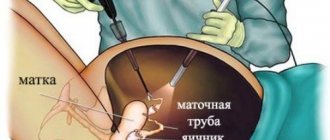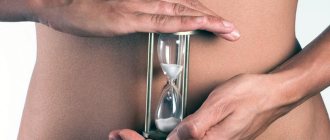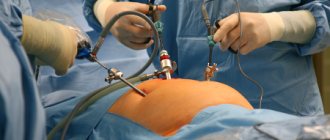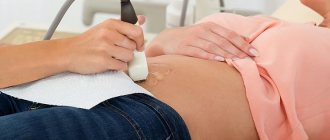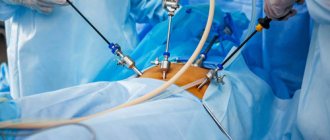Why is the recovery period shorter with laparoscopy?
The laparoscopic method of surgery is practiced in operations on the lungs (thoracic operations), organs of the urinary system, gynecology, and gastrointestinal tract. Laparoscopy is performed using a special device (laparoscope) equipped with a light system, a video camera and an additional surgical instrument (trocar). The necessary medical instruments are introduced into the patient's body through small incisions.
The image captured by the camera is reproduced on the monitor, and the doctor can examine in detail each individual area of the operated organ. Surgery is performed under general (less often local) anesthesia. Laparoscopic surgery takes a shorter period of time and does not disturb the external aesthetics of the body. Soft tissues are subject to minimal trauma during the intervention.
The sutures are protected from infection due to their tiny size and heal much faster. The time spent in the hospital does not exceed 2–4 days. Recovery time at home is also shortened. When the operation is performed correctly, complications rarely occur. Typically, such troubles occur due to the fault of patients who do not follow the postoperative rules of nutrition and physical activity. In particular, they do not maintain the time period determined by the doctor until the moment when playing sports after laparoscopy can be done without fear.
Diet
Already on the seventh day after laparoscopy, you can eat normally and eat everything except fatty, salty and spicy foods.
It is not recommended to eat on the first day after laparoscopy. You can use still, purified water. On the second or third day, you can already eat steamed or boiled vegetable dishes and white chicken meat in small portions. You can also have buckwheat porridge and fermented milk products. You need to eat little by little, in small portions. You can't overeat.
Already on the seventh day after laparoscopy, you can eat normally and eat everything except fatty, salty and spicy foods. It is especially recommended to consume vegetable broths, light soups, cereals and fresh fruits and vegetables, fermented baked milk, kefir, and cottage cheese. In addition to spicy, salty and fatty foods for a month, there is a strict ban on alcoholic beverages, smoking and coffee. It is recommended to drink herbal tea, compotes, still water, and fresh juices.
Recovery after laparoscopy
According to medical data, the final recovery of a patient who has undergone laparoscopy occurs after 2–4 months, depending on the complexity of the operation. In the absence of complications, it is recommended to get up the next day after surgery. Walking at a moderate pace is necessary to avoid adhesions in the operated area and to establish normal blood flow. This will help prevent the possible formation of vascular blood clots.
However, you should not force the rehabilitation period and exercise excessive physical activity. Laparoscopy, although less traumatic, is still a surgical operation. Movements should not be sharp and energetic, or cause discomfort or pain. If pain occurs at rest, the patient may be prescribed analgesic drugs.
Lifting and carrying heavy objects is strictly prohibited
Weakness and nausea usually leave the body on their own after two days. In most cases, this condition is a reaction to general anesthesia. Modern materials used for stitching fabrics tend to dissolve on their own. If ordinary surgical threads were used when suturing, they are removed on the 7th – 10th day.
The patient’s responsibilities during the rehabilitation period include:
- adjust the diet;
- dose physical activity;
- observe the work and rest schedule;
- exclude bath procedures, visits to the sauna and solarium;
- do not lift heavy objects;
- abstain from sexual intercourse for a month.
If any negative manifestations occur, you must seek medical help.
It is not recommended to eat food in the first 24 hours after surgery. The liquid consumed should be gas-free and sugar-free. Green tea and water are allowed. In the postoperative week, you should switch to a lighter diet. The attending physician will prescribe a specific diet that will help restore strength for further sports activities. It is prohibited to drink alcoholic beverages for 3–4 weeks.
Physical activity after cholecystectomy
Already a month after laparoscopy and two months after laparotomy, if the patient feels normal, it is recommended to start visiting the pool.
Swimming (without increased sports activity) is an excellent alternative to gentle abdominal massage.
Also, after this time, quiet walking walks lasting forty to fifty minutes outside the premises are recommended.
Such physical activity minimizes the risk of bile stagnation and allows you to better enrich the body’s tissues with much-needed oxygen. Normal saturation of tissues with oxygen helps to increase the intensity of metabolic processes, normalizes the functioning of the liver and the entire biliary system. One of the ways of such walking is the so-called Nordic walking, which takes place at a moderate pace using ski poles.
In any case, the level of current physical activity is determined only by the attending physician, and you should not experiment here on your own.
At the initial stage of rehabilitation after cholecystectomy, you will have to give up active sports (even fast running is not recommended), since at this time there is a high risk of severe pain. Also, you should not lift heavy objects at this time, as this will negatively affect the normal formation of the postoperative scar.
Breathing exercises
While walking, you need to pay close attention to your breathing.
Exhaling quickly causes the diaphragm to put a little pressure on the liver, which helps release bile and blood from it. Such a natural breathing massage of this organ for twenty to forty minutes a day can significantly increase the functionality of the liver.
This breathing exercise (deep inhalation/quick full exhalation) can be practiced not only while walking. For example, it is recommended to perform the following breathing exercise daily:
- press your open palms firmly against your stomach so that your thumbs touch your lower ribs;
- take a slow deep breath; in this case, the chest should not rise, but the stomach, on the contrary, should be filled with air as much as possible;
- hold your breath for two to three seconds;
- exhale forcefully while simultaneously drawing in your stomach.
Read also: How are the liver and gallbladder connected?
This exercise should be performed two to three times a day on an empty stomach. Each procedure should consist of two to four series, each of which should have three to four cycles. One cycle - one deep breath and one strong exhalation. Between series you need to rest from 3 to 4 seconds.
Physiotherapy
Morning exercises are allowed two weeks after daily walking has begun.
Such exercises help to activate the functioning of the internal organs of the digestive system and normalize bile outflow.
When can you exercise after gallbladder removal? Heavy physical activity on the body muscles is prohibited for a period of six months to a year after the operation.
Inna Lavrenko
auto RU
This is especially true for loads affecting the abdominal muscles (it cannot be pumped), since this kind of load very often causes the formation of postoperative hernias. In any case, permission to fully engage in sports must be given by the attending physician.
If the patient is overweight, he is recommended to wear a support bandage.
This allows you to reduce the load on the press and prevent the occurrence of a postoperative hernia. This support belt should be worn throughout the day and removed at night. The duration of wearing the bandage is determined by the doctor, based on the patient’s well-being.
Morning exercises as a guarantee of health
Physical education and sports after laparoscopic surgery
The answer to the question of how long after you can start exercising depends on the specific case. A physically prepared body copes with the stress received during surgery much faster. If, for example, a woman actively trained before laparoscopy, her motor rehabilitation period may be shorter. For older people, physical recovery is more difficult and slower.
Adhesions after laparoscopy
There are general recommendations for the physical restoration of the body and the resumption of active training, which can be adjusted to the individual characteristics of the body and health status. To optimize the time and load parameters of physical activity, the best option would be to consult a sports doctor. If this is not possible, it is necessary to consult with your doctor and a medical specialist in the field of exercise therapy (physical therapy).
Most operations performed laparoscopically affect the internal organs of the female reproductive system or the digestive tract. This must be taken into account when creating a training schedule. Loads on the anterior abdominal wall are contraindicated in the first month; subsequently they must be strictly dosed.
Recovery is facilitated by regular exercise with moderate energy, carried out in the fresh air.
Where to begin
In order not to harm your health, it is necessary to accustom your body to physical activity gradually. The best option would be to start with daily walking. Thus, the muscular, cardiovascular and respiratory systems will be strengthened. You can start with a 5-10 minute walk, each time trying to increase the time and distance. You should not walk alone, as a weakened body can fail at any moment.
Dosed loads
After three weeks, you can gradually move on to a therapeutic gymnastics complex to strengthen the musculoskeletal system. Exercises must be performed daily, strength loads should be excluded. Gymnastics can be done in a vertical and horizontal position. If pain occurs, it is recommended to reduce the intensity of the load and the time of exercise.
A single session can last from 10 to 20 minutes, depending on how you feel. Overloading the body is extremely dangerous. This is especially true for women watching their weight. In pursuit of slimness, young ladies often exceed the permissible norm of vigorous exercise, which invariably leads to the development of complications (hernia, bleeding).
Exercises and rules for doing them
It is recommended to perform only exercises to train diaphragmatic breathing on your own. The rest of the complex must be selected individually, taking into account the physiological characteristics of the patient. To do this, you should seek help from a physical therapy specialist.
Lying down
Diaphragmatic breathing is trained as follows: lying on your back, you need to inflate your stomach when you inhale, and when you exhale, slowly draw it in. Next exercise: imitation of walking while lying on your back. To perform this, you should alternately bend your knees and then straighten them again. Continue for at least a minute.
You can simultaneously pull both legs towards your stomach. And also the legs can be raised from horizontal to vertical position without bending the knees. The following recommendations: resting your elbows on the floor, you should raise and lower your pelvis, then perform the “bicycle”, “scissors”.
Regular training
Sports training with moderate load is allowed no earlier than after two months. Strength exercises should be postponed for 3–4 months (with strip surgery, patients are not allowed to do strength training with minimal load for six months). You need to start with a minimum weight, no matter how long a person has been playing sports. The permissible weight of equipment should not exceed 5 kg for men and 3 kg for women.
The time interval for physical education in a gentle mode depends on the condition of the sutures, the absence of complications, and the general tone of the body. If the recovery period proceeds in the correct mode, the patient usually returns to preoperative sports activities after 5–6 months. For professional athletes, a sports doctor monitors their health. Rehabilitation training is developed individually, taking into account the type of sport, general physical readiness, and the complexity of the laparoscopic surgery performed.
The power load must not be exceeded. Otherwise, there is a high probability of developing a hernia
Exercise after surgery
Train with us! →
Fitness
→
Training after surgery
No one is immune from surgical intervention. And if suddenly the operation came as a surprise and temporarily interrupted many years of training, then it becomes very disappointing.
I'm not talking about professional athletes now; many of them have to return to sports within a very short period of time after surgery. Amateurs will need at least two months for rehabilitation.
This question concerns the author of the article directly, so we decided to discuss it on the treneroa.ru website.
Proper rehabilitation after surgery: how not to make a mistake?
Surgeries are different and the recovery period is also different. But even after the most difficult operations, you can fully recover and continue playing sports. But for this there must be proper rehabilitation. What does it mean? This is a specially selected set of exercises and techniques that will allow a person to return to their previous loads after some time and even improve the result.
In general, the rehabilitation process is individual for each person. It largely depends on what kind of life you led before the operation. If you led an active lifestyle and played sports, it will take you a little time to recover. Soon you will get into the usual rhythm of training, but you still need approximately two to six months.
If before surgery you were on good terms with sports, then the recovery period may drag on for a long time.
In such cases, doctors recommend that you first lie down properly, and then slowly begin to engage in special physical therapy or undergo a course of special therapeutic massage.
Of course, all exercises should be done under the supervision of a trainer or massage specialist.
IMPORTANT!
After surgery you should remember:
- During the rehabilitation period, training with only a small amount of physical activity is allowed: running, swimming pool, athletics, therapeutic exercises
- If you feel pain or discomfort when you start training, you should abstain from training for some time: your body is not ready yet, be patient for ten days.
- After strip surgery, doctors do not recommend lifting weights for 3-4 months, and you should refrain from heavy loads and exercise in the gym for the same amount of time.
Yoga and Pilates as an alternative to training
Unfortunately, it is not always possible to choose an individual program. In this case, you can start doing yoga or Pilates. These lessons are the most effective way to prepare your muscles for full load. In addition, yoga or Pilates will help you tune in to the wave of recovery and improve your physical and mental well-being.
With their help, you will stretch and strengthen your muscles, develop and strengthen your joints and ligaments. But before you start, it is better to consult with a specialist who will tell you which yoga asanas are recommended for you and which ones you need to abstain from for now.
After a while, when you get involved, your muscles, joints and ligaments will be ready for intense exercise, and you will be able to constantly maintain your physical fitness.
You can, of course, do yoga and Pilates at home on your own. But it’s better to start training at a sports center. The classes are taught by instructors who will not only tell you what to do, but also how to do it correctly.
In addition, in sports centers, before starting training, it is suggested that you undergo an examination by a sports doctor. In this case, you will have his conclusion in your hands and you will be able to rely on it. And in the future you will be able to compare your performance.
Still, an operation, even the easiest one, is serious, and when playing sports, you need to listen to yourself and your feelings.
I also had to undergo abdominal surgery. And the ban on sports and any physical activity in general for at least two months really upset me. Therefore, as soon as this period expired, I immediately started studying. Of course, I didn’t return to my constant load right away, but now, after a year and a half, I’ve even increased it.
I started with yoga, now I have increased the number of approaches, the intensity of the load and use weights during classes. I quickly returned to my previous workload, and I had already forgotten even the forced break for two months.
After all, there is nothing better than excellent physical shape, which is not a hindrance to surgery! Better yet, never end up on the operating table and never stop practicing.
We offer you an approximate complex of therapeutic exercises in the postoperative period:
The video shows simple exercises for people who have undergone strip abdominal surgery:
Source: https://www.trenerovka.ru/fitnes-posle-operacii.html
Intimate life as part of physical activity
Since sexual relations are considered physical activity, after surgery it is necessary to abstain from sexual activity for a month. In the case of gynecological laparoscopy, this period can be extended to 2 months. Just like basic physical activity, intimate life should not begin with increased loads. Rationally planned physical education classes will only bring benefits to the body. The main thing is to find a middle ground so that the process of rehabilitation of motor activity does not lead to complications.

